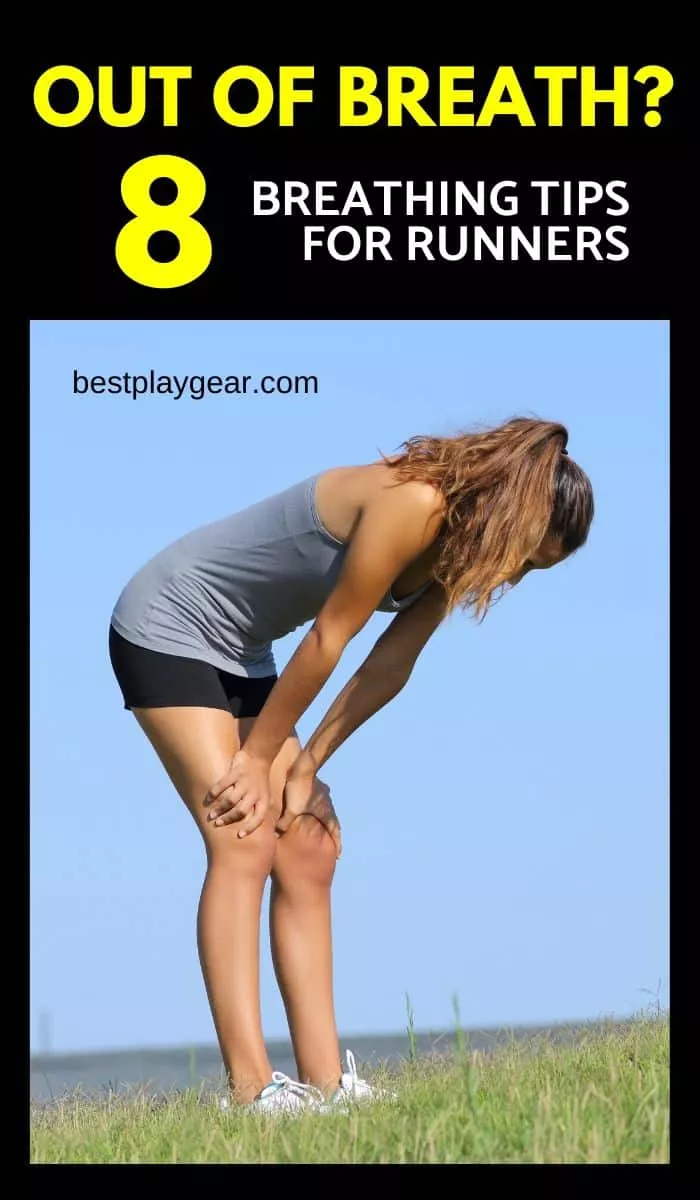[aff_disclosure]
Ufff!
I’m again out of breath
Why I’m no able to run even for 15 secs?
Why am I panting so much?
What wrong am I doing?
Well here are the answers.

8 essential breathing tips for runners. If you are out of breath while running and want to improve your lung capacity, here are the breathing tips that will help you with running.
8 Essential Breathing Tips for New Runners
After going through my own leanings and mistakes, I figured, only these breathing tips can help you as a new runner
1. Slow Down
If you find yourself, catching breath often, then it may mean that you are running too fast.
But before even starting to run, visit your physician to get a checkup done.
This will eliminate any problem related to your lungs like asthma, etc.
Once, you have eliminated that, you can be confident that you can start off with any beginner running plan
Now back to breathing.
So, you are stopping too often to catch your breath.
Which means?
You are running too fast even if you don’t think so.
You may be out of shape and has started run recently.
So, this is normal.
You must slow down to a conversational pace means, you should be able to continue with normal conversation while running
Otherwise you are running too fast.
How should you train yourself to breath?
Since you are a beginner and probably out of shape, you should start by walking
This is the most effective way to start your journey.
Steps for breathing properly:
Step 1: Go for a short walk, for 10 to 20 min
Step 2: During the walk, you should focus on deep breathing. [Will show you how to deep breath later in this article]
Step 3: Concentrate on expanding your belly as you breath in.
Step 4: Focus on contracting your belly when you breath out
Try to make the exhale time more than your inhale time.
This will clear all the CO2 from your lungs and will make room for your more Oxygen when you breath in next time
Do this for 2 weeks, 3 times a week
Step 5: For the next two week, try 1 min brisk walking and 1 min normal walking.
Keep your breathing pattern same.
This will make you more focused on your running but will train your breathing muscles to adjust with pace.
Step 6: For the next two weeks, try to do slow jog for 1 min and normal walking for 1 min
Maintain the same breathing pattern
Sep 7: Finally, start running for 1 min and jog for 1 min while maintaining the breathing pattern
But remember, not to go crazy on the pace. You will not be able to maintain your rhythm that you have gradually built.

Breathing exercises for runners are very important. If you want to have strong lungs and want to improve your breathing while running, these breathing exercises will help you out.
2. Rhythmic Breathing
Once you are into 2 to 3 months of training, it’s time to tie your breathe with your steps.
With the above level of breathing exercise, it should be fairly simple to do.
What are the patterns and when to use them?
These are the common forms of rhythmic breathing patterns:
- 3:2 – For beginner runner. Here you will be inhaling for 3 three steps.
Let’s call it as LEFT, RIGHT, LEFT
Then you will exhale for 2 counts. Which is RIGHT, LEFT.
If you are finding it difficult to do it in your current pace then slow down a bit.
With regular practice, you will be able to master this technique very easily.
- 2:2 – This is more suited for intermediate runner or for interval/tempo runs
Here you will have to inhale for two steps (LEFT, RIGHT), and exhale for two steps (LEFT, RIGHT)
This is more labor-intensive and a beginner should avoid this
- 2:1 – Again they are meant for intermediate runners or for interval/tempo runs
Here you will inhale for two steps (LEFT, RIGHT) and exhale for one step (RIGHT)
- 1:1 – This is for running at your maximum speed. This is usually used by runners at the last stage of a race.
Here you will be inhaling for 1 step (LEFT) ad exhaling for 1 step (RIGHT)
So, for a beginner, 3:2 is the best. You may progress to the other patterns as you gather more experience.
3. Deep Breathing
Deep breathing is the most essential skill that you can acquire.
Regardless of your experience and the breathing pattern you are following, without deep breathing, you cannot go far.
It will help to increase your lung capacity and will overall improve your pace, stamina and efficiency
As per Wikipedia
Diaphragmatic breathing, or deep breathing, is breathing that is done by contracting the diaphragm, a muscle located horizontally between the thoracic cavity and abdominal cavity. Air enters the lungs and the chest rises and the belly expands during this type of breathing.
How to train yourself for deep breathing?
If you have followed the steps of ‘Slow Down’, then you are already a PRO with deep breathing
But if you are still struggling to grasp it, follow these simple steps:
- Lie down on your back.
- Keep your upper chest and shoulders still.
- Focus on raising your belly as you inhale.
- Lower your belly as you exhale.
- Inhale and exhale through both your nose and mouth
4. Using nose or mouth…
In our day to day life, we breath through mouth.
However, while running this may always not be true.
With any sort of intensive workout, demand for oxygen in your body increases.
As a result, we generally switch to a mouth breathing automatically.
So, to have the maximum oxygen intake, you should inhale through both nose and mouth
This way, you will be able to provide more oxygen to your body and will be able to perform better
FAQs
5.How Can I Train My Breathing Muscles Better For Running?
To train your leg muscles you do exercise right?
These exercises strengthen your hips, hamstrings, calves etc.
It is the same for breathing.
You have to do regular exercise to make them stronger.
In fact, weak breathing muscles are one of the main reasons of early fatigue in marathon.
There is a simple exercise to get started:
- Lie down on your back
- Breath deeply so that your abdomen rises with your chest
- Count 10, then release the breath
- Watch your abdomen contacts with your chest.
- Again count 10, then inhale.
- You should try to reach to a point where you will not see your chest moving
You can also try the below exercise:
6.What Rhythmic Breathing Should I use for runs?
Rhythmic breathing exercises are vital for you t o perform your runs better.
They are generally described as 3:2 or 2:2
This means you should inhale for three steps and exhale for two steps.
After understanding that, the next step for you will be to blend the rhythmic breath with your runs:
Easy Runs Or Warm Ups
Use 3:3 for easy runs and warm ups .
This will allow your lungs to get enough oxygen and to prepare your body for the upcoming exercise session
However, this is just a guideline.
If you don’t feel comfortable to use 3:3 then you can always switch to a pattern that will help you
But remember not to switch to slower than 3:3. Your body will not be able to eliminate CO2 properly.
You can try a 2:2 or 3:2
A 3:3 rhythm enables you to take about 30 breaths per minute.
Also, it gives you ample time to process carbon dioxide while still getting the oxygen required amount of oxygen.
Moderate Runs
When you are doing moderate runs, you should switch to a 2:2 breathing
This will help you take 45 breaths per minute.
This pace of breathing is perfect for tempo runs and marathons
Hard Runs
Imagine you are at the end phase of race.
Your do or die situation.
This is what hard run is all about.
You can use 2:1 or 1:2 based on your preference
1:1 might not be good as your body will not have enough time to eliminate the carbon dioxide.
So, stick to 2:1 or 1:2. It will work
7.Should I Breathe Through My Nose or Mouth While Running?
As ,explained earlier, using both will help you improve your performance.
But why is it bad to breath with only chest?
When you are breathing through chest, you are filling your lungs with oxygen.
But when you are exhaling, your chest muscles are incapable of expelling the entire load of CO without the help from diaphragm
So, a portion of the CO2 remains in your lungs and may cause side stitches.
That is the reason, you should breath with both chest and abdomen.
Also, breathing through both chest and abdomen will strengthen your breathing muscles thus helping you to perform better
8.Why Will Fixing My Breathing Help Me?
We use breathing rhythms to monitor the intensity of our runs.
However, it an also be used to monitor other aspects of running as well.
Pacing
If you pay close attention to breathing rhythm, it can help you to monitor your pace during the runs.
How?
Watch your breath and check if it is increasing or decreasing.
They have a strong co-relation with your pace.
If you notice that it has increased, then you may have accidentally increased your pace.
This technique is especially helpful for runners who struggle to maintain a steady pace.
Hills
Running on the hills can be tricky.
If you don’t know the exact grade and height of the hill, you will not be able to adjust your pace.
But, if you are using a 2:2 breathing through the race, then you should focus on maintain that during the hill ascent as well.
This will automatically adjust your pace when going uphill or downhill.
Side Stitches
Side stitches are common among runners.
The probable reason being, your body not able to expel the entire load of CO2 as explained earlier.
Another reason could be due to undue stress to the diaphragm.
It will only worsen if you continue to shallow breath.
So, to handle that, switch to a slower breathing rhythm like 3:3.
It will gradually ease the discomfort.
Conclusion
Learning to breath, is essential for any kind of sports and is very much needed for running.
If you put in a little bit of effort, it is not difficult to master.
So, focus on your breath and master these essential breathing tips for new runners.

Do you get out of breath while running? Here are some breathing tips for runners that will help you to improve your lung capacity. Follow these running tips and run more distances without getting out of breath.

Madhusree Basu
Author, Admin
Blogger and a fitness enthusiast. She loves running and Yoga and everything in between. She started running to manage her weight and to eat to her heart’s content. A true foodie at heart she shares whatever knowledge she has gained throughout the years about weight management and fitness.
Recent Posts
Brooks Hyperion Tempo Vs Ghost: Choose The Best One? [2024]
The Brooks Hyperion is lighter and snappier than the Brooks Ghost which cushier. Both shoes are suitable for various activities. Brooks Hyperion tempo has a more elite feel to it and Brooks Ghost has different versions like Ghost Max, and Ghost GTX.
How To Train For A 6km Run In 2 Weeks?
How To Train For A 6Km Run In 2 Weeks? This is a tough thing to achieve…but we have a plan…find out here, if you want to run a 6K in 2 Weeks
Are Hokas Good For Heel Strikers?
Are Hokas Good For Heel Strikers? We did a deep dive into that…Find out here…
Why Are ON Cloud Shoes So Expensive? (21 Reasons Why…)
Why are ON Cloud shoes so expensive? There are so many reasons for that. If you want to find out why On Running shoes are expensive…Read on…
7 Best Women’s Running Shoes for Sesamoiditis Reviewed in [2022]
7 Best Women’s Running Shoes for Sesamoiditis Reviewed in 2022. Merrell Women’s Trail Glove 6 with no toe-spring is probably the perfect choice for sesamoiditis. Brooks Women’s Adrenaline GTS 22 Running Shoes have excellent cushioning at the forefoot to protect your sesamoiditis. Brooks Women’s Ariel ’20 Running Shoes are good for overpronators who have injured their sesamoid bone. Altra Women’s Paradigm 6 Running Shoes. New Balance Women’s 840v5 Running Shoes. Vibram Women’s V-RUN Running Shoes. Hoka Bondi 7 Running Shoes.
Topo Phantom Vs Hoka Clifton: Which One Is The Best For You?
Topo Phantom Vs Hoka Clifton. Comparing something this similar is interesting. Check out what we found while comparing Topo Phantom and Hoka Clifton and who we think steals the show…

![Brooks Hyperion Tempo Vs Ghost: Choose The Best One? [2024]](https://bestplaygear.com/wp-content/uploads/2024/01/Brooks-Hyperion-Vs-Brooks-Ghost-Comparison.webp)



![7 Best Women’s Running Shoes for Sesamoiditis Reviewed in [2022]](https://bestplaygear.com/wp-content/uploads/2019/04/best-womens-running-shoes-for-sesamoiditis-HI-min.jpg)

